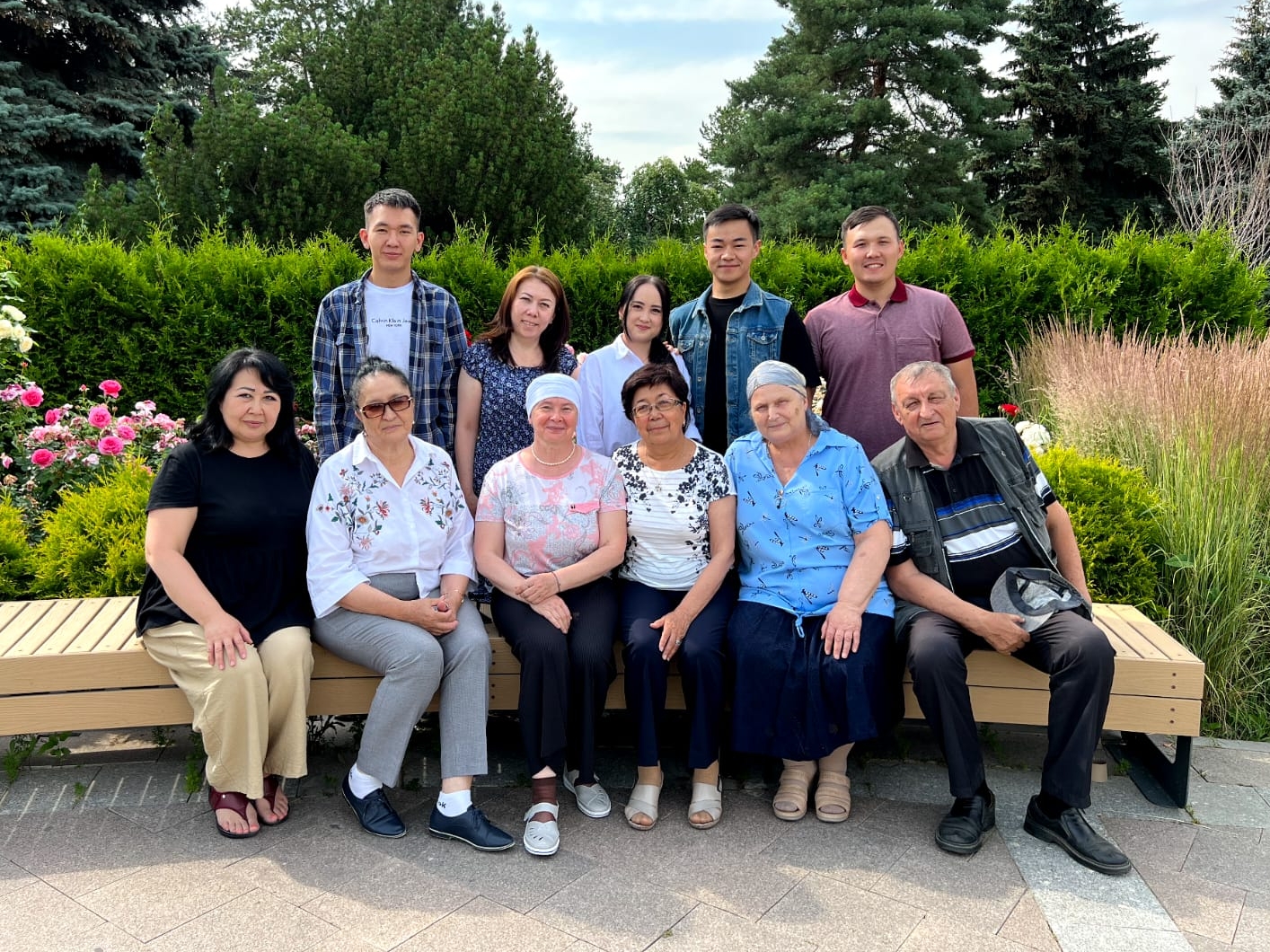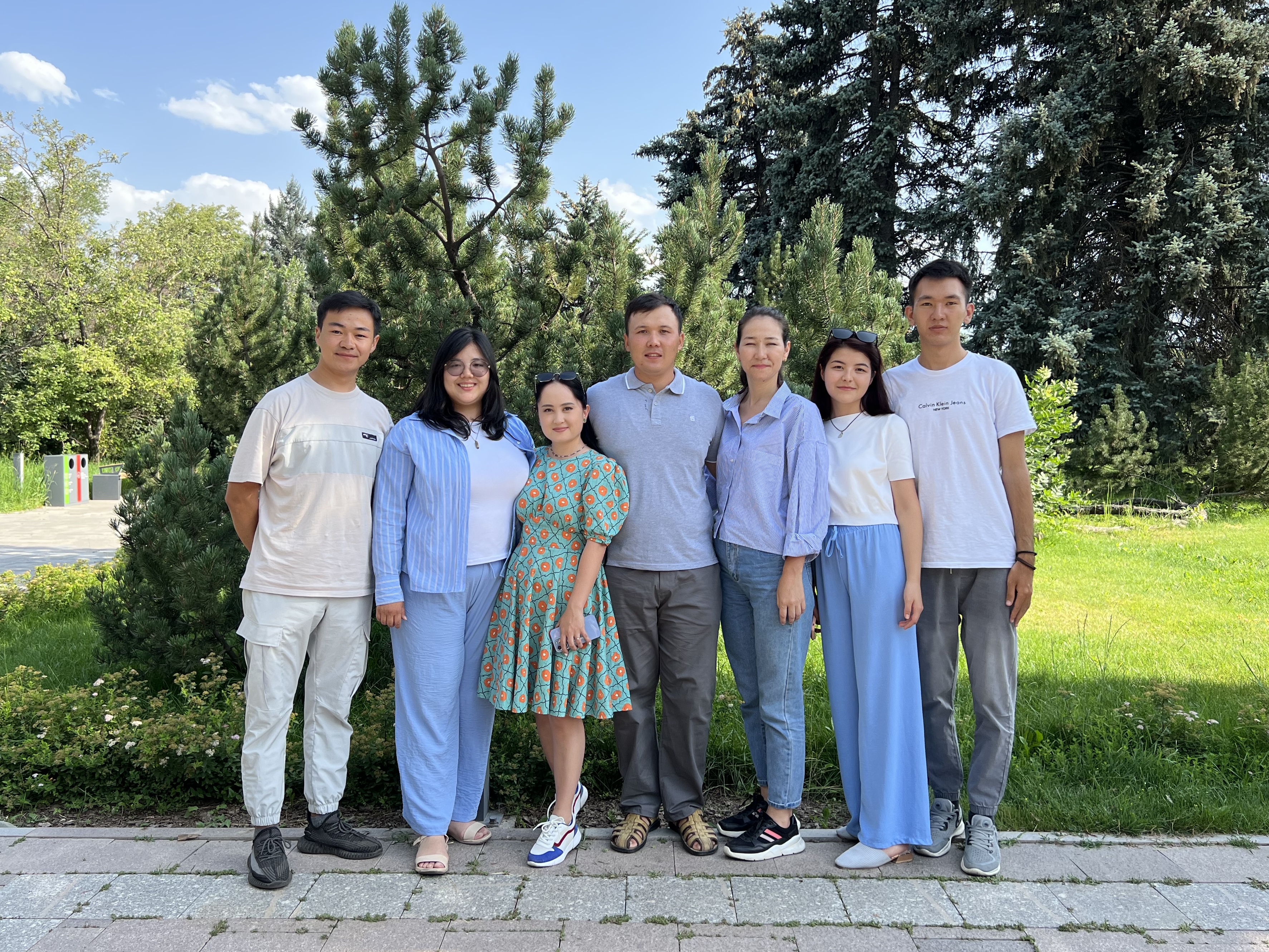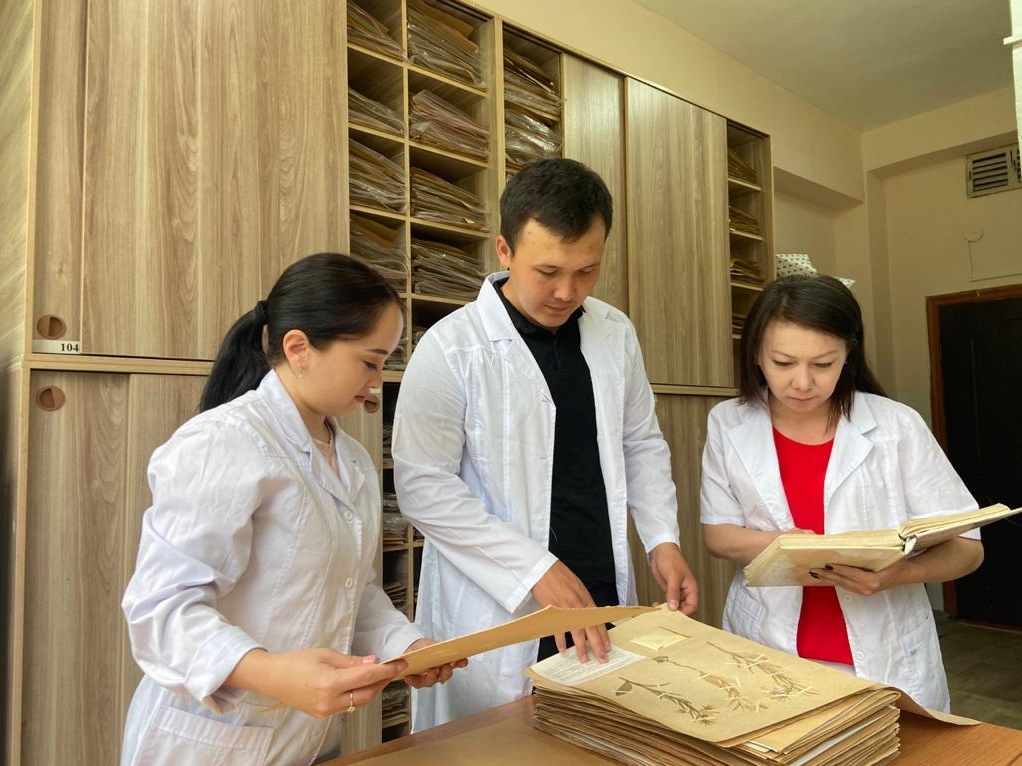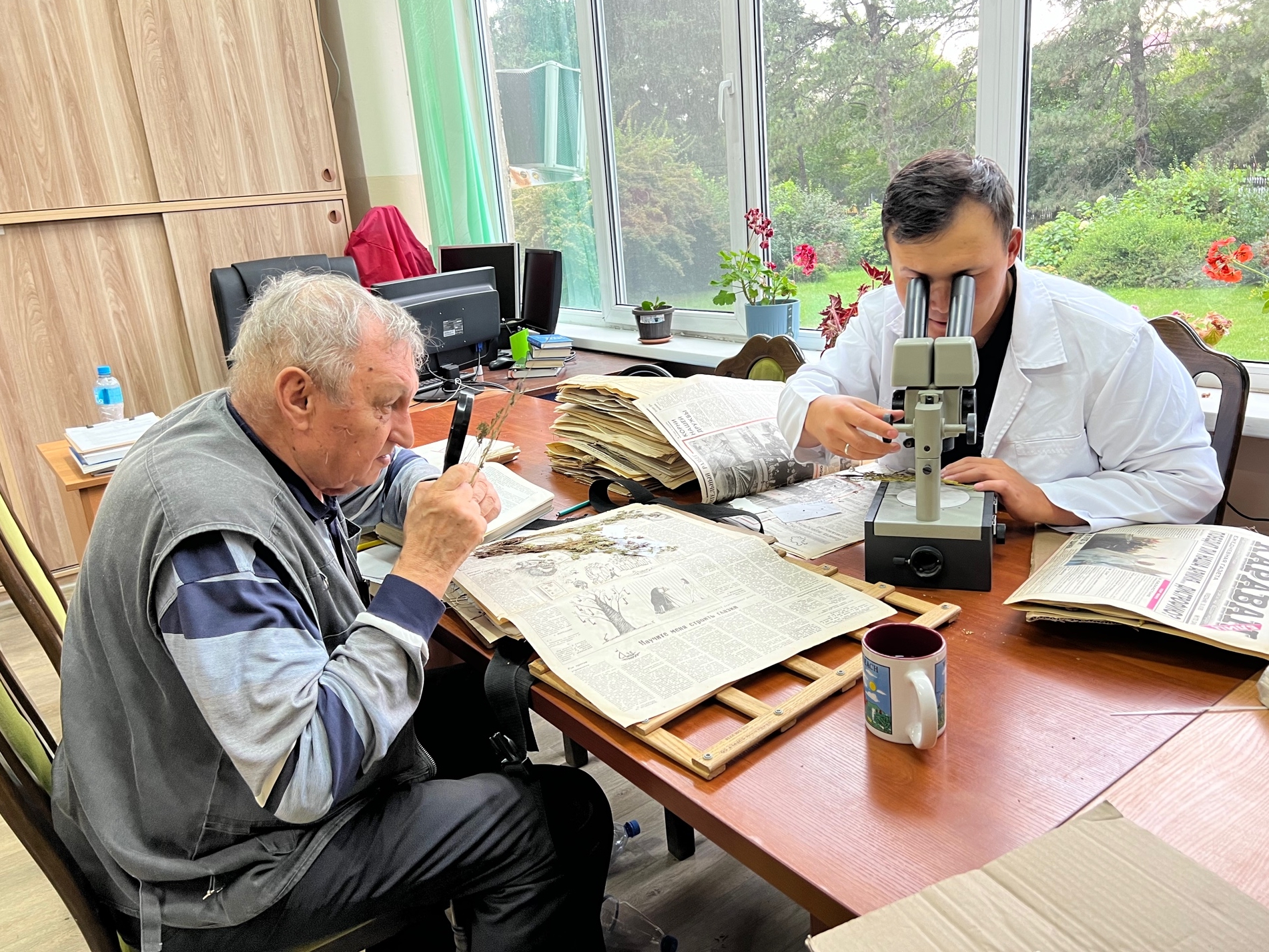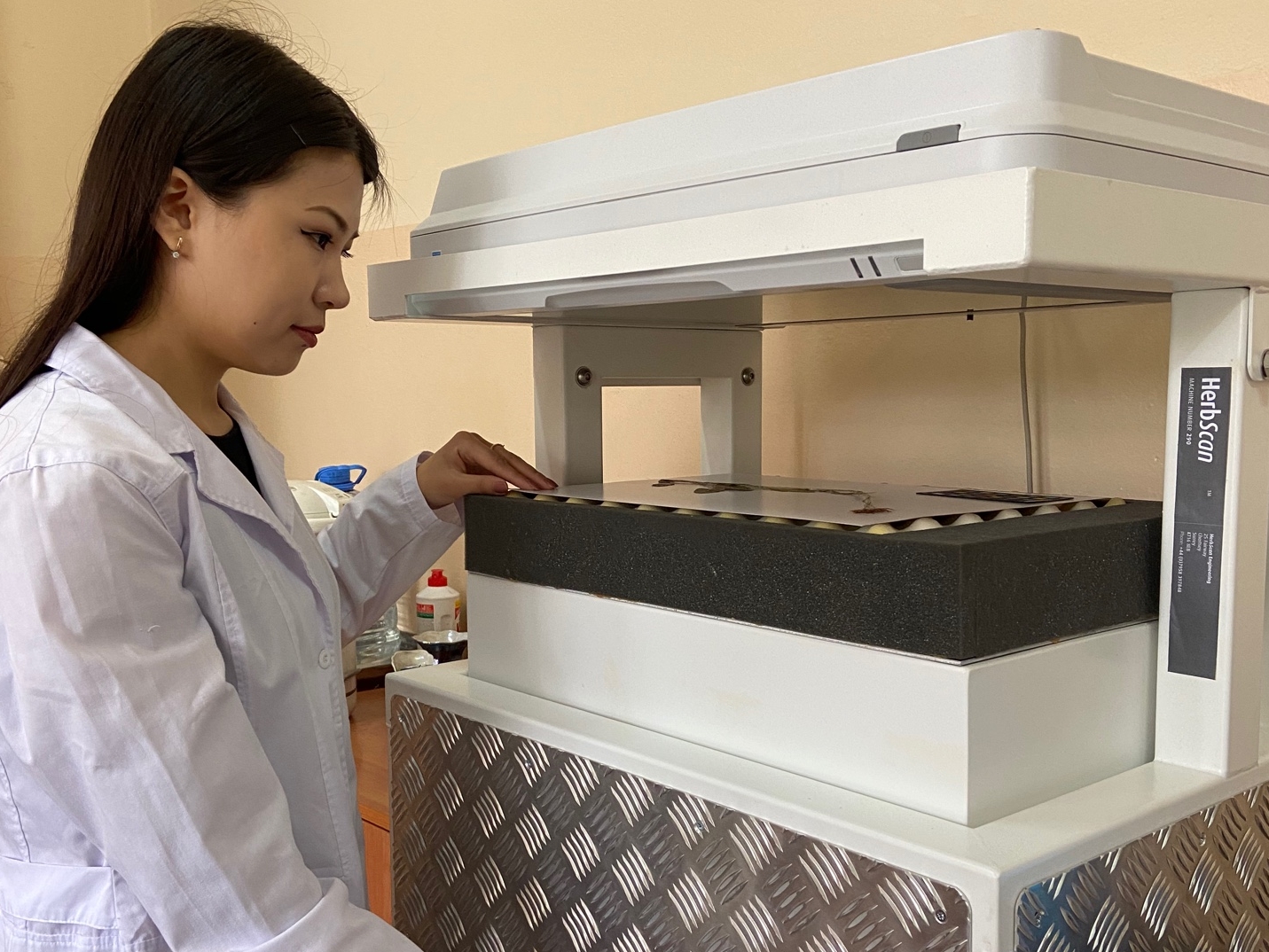Year of Establishment: The start of the forming of the laboratory of the flora dates back to 1932 in the composition of the botanical sector of the Kazakhstan facilities of the AS of the USSR, which managers were Shishkin B.K. (from 1932), Popov M.G. (from 1936), Pavlov N.V. (from 1937)
The year 1945 is the official date of establishment of the lab of the flora of higher plants as an independent administrative subdivisions of the Institute of Botany
Main focal areas of academic research:
The UN Convention on Biological Diversity was ratified by Kazakhstan in 1994, and as soon as in 1999 the National strategy for the conservation of biological diversity in Kazakhstan was developed, which provided for the implementation, firstly, of the full inventory taking of the biological diversity of the country, as the basis for the identification of its condition, for adoption of scientifically justified measures for its preservation. The great IMPORTANCE of this problem is emphasized, in its essence with floristic and taxonomy related research. The identification of the species diversity of separate regions, the study of systematic peculiarities of varying taxonomic level are referred to priority focal areas. For Kazakhstan, possessing over 6000 species composition of the flora, the given scientific research are most important.
The issue of provincial cadasters is deemed to be one of the stages for inventory taking of the flora of Kazakhstan.
The contemporary approach to identification and the preservation of the areas of concentration of rare and endemic species – the identification of key botanical territories is developing.
The establishment of the regional Red Books, which implementation experience is confirmed by the issue of the province of the Red Books (those of the South Kazakhstan, Mangistau, Zhambyl, Kyzylorda provinces).
For the purposes of enhancing the academic potential for the performance of academic research, young specialists (bachelor, master students) are engaged, who directly participate in the implementation of the specific objectives related to grants. For successful mastering a specialty, academic internships are provided.
Identification of the key botanical territories, which objective is to identify and preserve the areas of natural flora, possessing a high degree of diversity in which composition there are rare and vanishing species is referred to the focal areas, aimed at the preservation of natural resources.
The total number of staff of the lab: 15, of which there is 1 PhD and 8 Candidates of Sciences, 1 Master of Biology, 2 Master Students, 2 Bachelors, 1 Bachelor Student.
Total number of staff (general photo)
Lead Researchers:
Vesselova Polina Vasilyevna – Candidate of Biological Sciences
Danilov Mikhail Petrovich – Candidate of Biological Sciences
Mukhtubayeva Saule Kakimzhanovna – Candidate of Biological Sciences
Senior Researchers:
Sadyrova Gulbanu Auezkhanovna – PhD, Biological Sciences
Shormanova Aizhamal Abdraimovna- Candidate of Biological Sciences
Kurmantayeva Alfiya Aralovna, Candidate of Biological Sciences
Nelina Natalya Vassilyevna, Candidate of Biological Sciences
Zakirova Rauza Orazovna – Candidate of Biological Sciences
Junior Researchers:
Akhatayeva Dinara Abdrashitovna
Bilibayeva Botagoz Kurmanbayevna
Senior Lab Workers:
Zheksen Olzhas Bakhtybayuly
Zhumadilova Ainel Meirkhanovna
Serikkyzy Nurayiym
Kenesbay Akerke Khazhymuratkyzy
Osmonali Bektemir Birimkululy
LAB ACCOMPLISHMENTS 2013-2017
During that period the lab workers implemented 8 grant projects, participated in the implementation of 2 programmes, contractual works were also performed.
The basis for the performance of fundamental research is a unique Herbarium Fund, which was founded in 1933 on the basis of the herbarium of the local regional museum of the Semirechye by the prominent scientist, M.G.Popov. The Herbarium of the Institute is included in the list of the most important botanical collections of the CIS, of national importance, has an international index AA. The Herbarium presents the only storage of botanical collections, where the abundant floraa of Kazakhstan is most fully represented. The scope of the Collection fund continues to be replenished by the new collected plants. Lately, the foundation of the Herbarium Institute Herbarium rose to 259 thousand herbarium samples (fungi, gymnosperms, metasperms). The endemic and relic species of the flora of Kazakhstan are represented. Within the composition of the Herbarium, Herbarium of types is separated in which the taxons, new for the science, collected from the territory of Kazakhstan are represented.
For the preservation of herbarium collections, and its protection from the pests in 2014 the fumigation of the general fund of the herbarium was performed. In 2016 within the framework of the implementation of the RCF the full replacement of the old herbarium bookcases in the principal herbarium fund was carried out. Following the installation of equipment all the collection material was placed with the conformity of their taxonomic sequence. For the creation of the virtual herbarium fund in 2017 the scanning of collection samples was started.
The importance of the matter of preservation and development of collection funds was discussed at the session of the Parliament of the Republic (November 2016) (speaker Sitpaeva G.T.). In thеresolutive part and in recommendations to the Government of Kazakhstan, it was noted that, considering the international experience, in order to support and develop the collection funds it is necessary to assign to the Herbarium fund of the Institute of Botany and Phytointroduction of the status of the National heritage.
In 2012-2013 the employees of the laboratory of the flora of higher plants, jointly with the laboratory of micology and algology implemented the project “Creation and Preservation of Herbarium Collection of Rare Species (vascular plants, algae and fungi) as the scientific basis of the peculiarities of botanical diversity of Kazakhstan. The academic supervisor, PhD, Sitpaeva G.T. (implemented within the scope of the theme, “Ensuring preservation and development of collection funds of plants, animals, microorganisms, viruses and unique genetic banks as the basis of fundamental research”). In the course of implementation the screening of the contemporary condition of the flora and the microbiota of certain regions for the assessment of the rarity of the status and the creation of herbarium collections of rare species of vascular plants, algae and fungi, that need protection.
From 2012 to 2014 (jointly with the lab of geobotany) a grant project is implemented “Key Botanical Territories of Kazakhstan – the basis of the monitoring of the condition of the vegetation (with the example of Near North Tyan Shan botanical and geographical subprovince)” (jointly with the geobotanic labs). In the course of project implementation there were identified 32 KBT with the area of 13321 hectares. The floristic and phytocenotic diversity of the identified areas subject to species abundance and intracenotic structure of vegetation areas, the presence therein of rare and endemic species of plants. The given project was deemed to be the first targeted step towards forming the Kazakhstani network of the key botanical territories and inclusion of our country into the global network of KBT and it contributed to the adaptation of the existing methods, the search for new decisions in the sphere of conservation of plant world of the Republic. The results of implementation of works received acclaim at the 7 European conference for the preservation of the wild plants foEurope"Plants for people, People for Plants (city of Hanya, Cretes, Greece, 2014).
In 2013-2015 – the lab workers participated in the implementation of the academic and technical programme “Botanical Diversity of the Wild relatives of cultural plants of Kazakhstan as the source of enrichment and conservation of the genetic pool of agricultural, biological diversity for the implementation of food programme”. For the optimal performance of the works, the screening of collections of the herbarium fund collections of the Institute was performed, the locations of concentration of growing of wild plants of cultured plants were determined. For the collection of seed material the expedition research was implemented and Kirgiz Alatau, Tarbagatay, Zaissan hollow, ZailiyskiyAlatau, the valley of the Syrdaryariver was explored.
In 2015-2017 the workers of the lab implemented the PCF “Sustained Management of Genetic Resources of the State Botanical Gardens of the South-Eastern and Central Kazakhstan – the specially protected natural territories of the republican importance in conditions of transition to green economy (supervisor – Sitpaeva G.T.).
The Laboratory flora developed two sections. The development of the sections “Ensuring preservation and development of collection funds of the herbarium collections” provided for the complex of the sanitary and preventive activities for the conservation of the Herbarium Fund (fumigation, replacement of covers, labels and etc.). The main herbarium fund is replenished as materials, collected during the expeditions, by revising the herbarium material of the past years. The information is replenished which relates to the composition of floristic areas, the limits of species distribution and of their ecological allocation is specified.
In the section “The study of spontaneous flora of the Main Botanical Garden” the inventory taking of the spontaneous flora of the Botanical Garden shall be provided. In order to understand the processes of forming of the contemporary condition of spontaneous flora, the analysis of the species composition, represented in the herbarium fund database, was performed. The important objective of the research is the identification of the invasive alien species, the problem of management of whose behavior becomes global. The generalized material, received following the completion of the research, will allow to create a database of the spontaneous species, to allocate the invasive flora component, determine the measure of its aggressiveness.
The strategic focal area of the flora lab is the study of botanical diversity. Above all the study of rare, endemic and vanishing species.The study of rare elements of the flora, requiring the urgent and strict protection, the development of effective measures for the protection and the assessment of the contemporary condition of their populations. The research shall be performed which relate to the study of species diversity of the anthropogenically violated territories. These focal areas are reflected in the topics of 6 grant projects (2015-2017).
In the grant project “Contemporary condition of rare endemic species, and species threatened with extinction of the plants of Boroldaytau and the adjacent territories, within the limits of the Syrdarya Karatau” (supervisor Kurmantayeva A.A.). The main focal area of the research is the identification of the rare endemic species and of species, threatened with extinction in the western and the eastern part of Boroldaytau.
It has been found out that the territories of the cove of Baikalmak, the vicinity of the mountain Ulkentura, thte valley of the river of Borolday, the cover of Konyrtobe, Shakpak. The borders of the distribution of certain rare and endemic species, threatened with extinction in Boroldaytau were determined. There have been identified the areas of distribution of 24 rare species, included in Red Books.
Based on the results, obtained in the course of implementation of the project “Identification and Assessment of the Contemporary Condition of Populations of Rare, Vanishing and Endemic Species of Plants of Ketpen range and the development of proposals for the improvement of measures for their preservation (supervisor Sadyrova G.A.), the analysis has been performed of vanishing, rare, endemic and subendemic species of the flora of the Eastern part of the ridge, there have been identified 20 rare, endemic and subendemic species, 9 Red Book species of plants.
The grant project “Analysis of the Speices Diversity of the Flora of the Eastern Part of the ridge of KungeyAlatau, the transborder territory of Kazakhstan” (supervisor Mukhtubayeva S.K.) is devoted to identification of species diversity of the Kungey ridge. As a result of inventory of the flora of Eastern part of the ridge of KungeyAlatau, there was identified 1051 species of vessel plants. There have described 5 plots with the typical communities for KungeyAlatau ridge. For the assessment of the contemporary condition of the rare species of plants, included in the Red Book of Kazakhstan, there were built 6 monitoring areas.
Inventory taking of the floristic composition of the territories of the North Kyzylkum, used as forage, for forecasting the processes of dynamics of the vegetation was the objective of the implementation of the grant project “Monitoring of composition of the vegetation of cattle breeding cattle breeding – the scientific approach of the sustained use of desert pastures of Kazakhstan (with the example of Kyzylorda province)”. (Supervisors: Vesselova P.V., Kudabayeva G.M.). As a result fo research the species composition was identified and the preliminary index of cynanthropization of the flora of the Syr-Darya River, at locations of intensive cattle grazing, the Monitoring areas were constructed. The taxonomic composition fo the deserted areas of the rice fields of the Kazaly mountains, of which 50 % are represented by Pasqual weeds.
In the implementation of grant project “The identification of correlation of the species composition of the flora of the Kyrgyz Alatau, irrespective of the anthropogenic load” (supervisor – Nelina N.V.), the contemporary species composition of the flora of the gorges of Merke, Karakystak, Kayindy and Syugaty, the gorge of the Kyrgyz Alatau, there were identified the degree of anthropogenic influence on the dynamics of the floristic composition. The list of rare pants of the monitored territory, including 33 species and there have been proposed the areas fjro the establishment of the West Kyrgyz SPNT of the republican status.
The strengthening of the influence of anthropogenic factors entails the arising of the new type of anthropogenically transformed flora – urban flora, which is formed in the conditions of urban agglomerations and has a specific structure. In the course of implementation fo the project “Flora of the Urbanized Ecosystem of the city of Almaty” (supervisor – Sadyrova G.A.) analysis has been performed of the shrub and grass species of the urban flora of the Almaly, Aueezov, Zhetisu and Alatau districts of the city of Almaty, which is represented by 265 species. 3 parks and 1 grove of th4e city of Almaty have been researched. The analysis of the flora demonstrated a great percentage of the participation of the synanthtropic flora representatives.
In 2014 the second edition of the Red Book of Kazakhstan was published, which authors are mostly the employees of the Institute of Botany and Phytointroduction. The species composition is supplemented with 80 more species, in need of state protection.
The Lab employees actively participated in the preparation of the materials for EXPO-2016 (Antalya, Turkey). There was performed the selection of the primary herbarium material, collected during the expeditions in the past 3 years. More than 50 herbarium samples were selected for the herbarium panels. On demonstration panels there were represented the herbarium samples of species, characteristic for various zones and altitude mountain belts, their brief description was provided. The EXPO visitors showed special interest in those displays in which endemic, rare and relic species of Kazakhstan flora, paleobotanicimprints were represented.
LAB DEVELOPMENT PROSPECTS
The lab preserves and continues to implement the fundamental focal areas of research. First of all this is the inventory taking of the flora of various regions of Kazakhstan. Considering the increase in the human impact on all components of the biosphere, the evaluation of the contemporary state of the botanical diversity of the flora of the Republic is necessary. The research works related to the resolution of the theoretical questions of the evolution of the flora and certain taxons are going on. The works, related to the monographic processing of certain systematic groups of Kazakhstan plants are underway.
The regional Red Books implement the objective of preservation of rare, endemic and relic species, including resource plants of a certain territory, subject to destruction. During the period from 2002 to 2014 the provincial Red Books of the South and the South East of Kazakhstan were created. It is necessary to continue to implement this focal area of research, since this forms the basis for the new publications of the Red Book of Kazakhstan.
The lab has experience in creating regional Cadasters of Plants. It is necessary to continue the works for the creation of cadasters of all provinces of Kazakhstan.
Considering that over 50 years have passed since the publication of “The Flora of Kazakhstan”, the preparation of the 2nd Edition of the Flora of Kazakhstan is important.
The implemented grant projects for the research into the species composition of certain territories of Kazakhstan contribute a fuller inventory taking of the flora of the regions and they represent the stages for creating a summary of the flora of the Republic.
The Laboratory of the flora of higher plants is the keeper of the main Herbarium Fund of the Institute having a Republican Status. Considering the great volume of collections and its importance, the preservation and replenishment of the collection material is the main objective of the lab.
The introduction of the contemporary methods of preservation and further use of information resources, contained in the Herbarium funds is one of the priority and promising objectives of further work. The established database of collection fund is already making it possible to promptly use the available information material. Nevertheless it is necessary to create a virtual database for the species diversity of the flora of Kazakhstan.
